Common Materials, Uncommon Building
Locally sourced volcanic stone brings beauty to a Rwandan hospital as well as jobs and dignity to patients and workers
Stacey Freed
Reprinted by permission of the author and Building Stone Magazine
We often dismiss the things with which we come into daily contact. They are undervalued and unappreciated. In Rwanda’s Burera District, it’s pumice. These volcanic rocks are everywhere, and farmers remove them from their fields as if they are garden pests. But as it turns out, the mundane natural stone proved itself to be a change agent in this landlocked African country.
In 2007, the Rwandan Ministry of Health brought in Partners In Health to rebuild Burera’s nearly non-existent health system. Partners In Health is a global consultancy that works with governments to bring health care to some of the world’s poorest places. The following year, Partners In Health aligned with volunteer architects from Boston and Kigali-based MASS Design Group to create the site design and supervise construction for what would become Butaro Hospital.
At the time, Rwanda imported most building materials such as steel and glass from Kenya, Uganda, Turkey, and Dubai, making construction projects expensive. “Much of the construction happening was using imported materials and we wanted to see what could be produced locally to keep economic impact within the region to reduce cost and the environmental footprint,” said architect Alan Ricks, MASS Design Group’s founding principal. “What we saw in this very fertile region of Rwanda on the southern border of a chain of volcanoes was pumice stone.”
While it wasn’t unheard of to build with the local stone, doing so just didn’t have the cache of using imported materials. “Stone was seen as a low-value material, but it was available and affordable,” Ricks said. “We had to transform the perception of value from one focused on this commodity to one focused on craft. The inhabitants saw the stone as a nuisance with little value, but it was beautiful.”
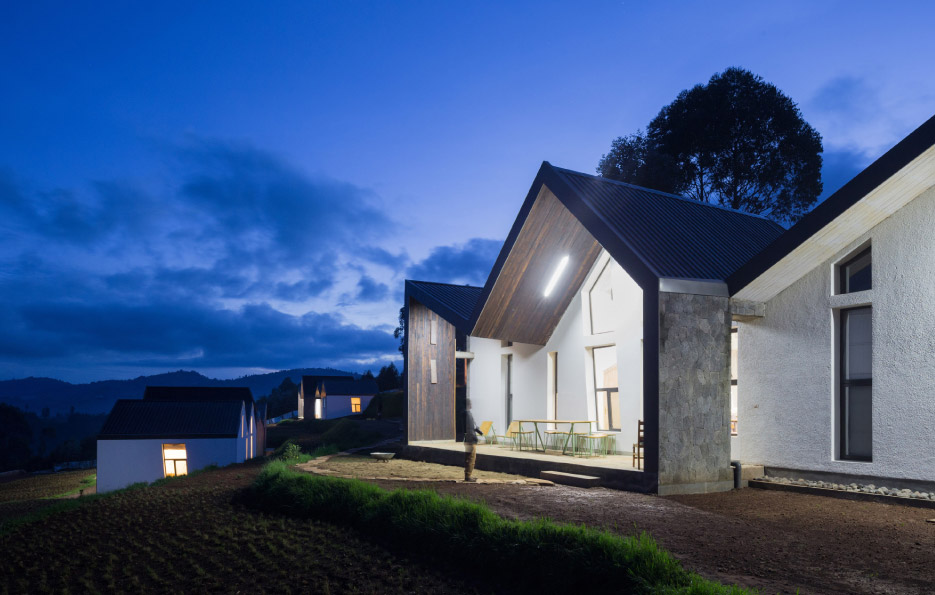 |
Architecture of Service
MASS (Model of Architecture Serving Society) Design Group was founded by Ricks and Michael Murphy as a nonprofit architecture firm devoted to improving lives through beautiful and impactful buildings. Ricks told a New York City TED audience in 2014 that “we start by rejecting the notion that some deserve the full benefits of architecture and others the bare minimum…. We need to constantly ask how the choices we make have the greatest impact on the communities we serve.”
That philosophy would serve Ricks and Murphy well when, as students in the Harvard Graduate School of Design, they began volunteering on the Butaro project. They, along with others from MASS, would put in 25,000 hours of volunteer labor over the course of a decade.
When it came to hospital design, Ricks and Murphy had read the studies that showed that tuberculosis spread in hospitals via crowded, unventilated hallways and waiting rooms. They’d read the studies that showed that patients recover 25 percent faster with a view of nature. They considered that data as they designed Butaro Hospital. “We really immersed ourselves in Partners In Health’s philosophy of health care delivery and tried to imagine what that meant for architecture. They saw that physical space was important but so were aesthetics. They invested in building gardens around the clinics they built to creates spaces for healing and also of dignity,” Ricks says. Using the local volcanic stone became a part of that philosophy.
MASS designed a 64,583 square-foot, two-story hospital with external covered walkways, and took into account patient and staff flow and natural ventilation systems to mitigate and reduce the transmission of airborne diseases. The buildings were designed to be “passively ventilated without heating or air conditioning. Instead, we used basic design principles to achieve thermal comfort,” Ricks said.
Built on land formerly used as a military encampment, the project also includes gardens, fishponds, landscaping, and small houses for doctors. “Recovery is about more than hospital structure,” Ricks told his TED audience. “We designed a hospital to be healthy, effective, efficient. This is what you’d expect an architect to do. We wanted to make a statement to create dignity in the community. A garden helps people feel joy and happiness and recover more quickly.”
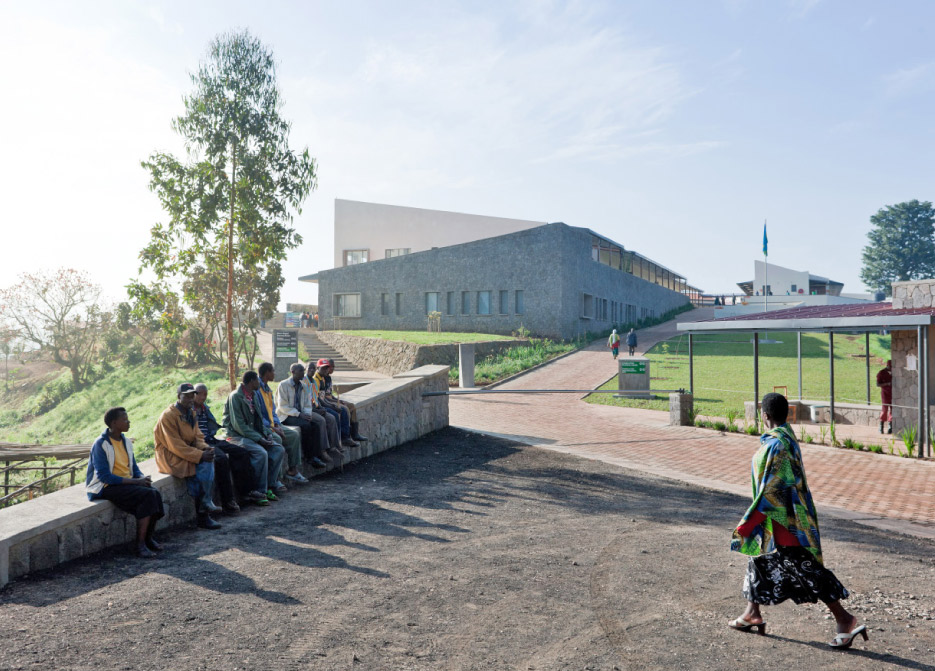 |
|
Above: Butaro Hospital, Rwanda. Photo by Iwan Baan Below: Local pumice stone was viewed as a low-value material, but it was available and affordable. Photo courtesy of MASS Design Group |
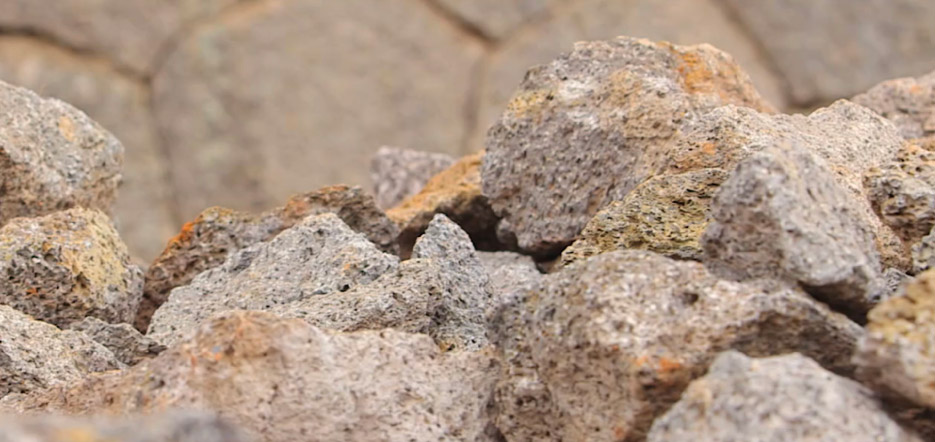 |
Since the volcanic rock is ubiquitous, there was no need for extraction, Ricks says. Farmers pulled the pumice stones from their fields and piled them up or used them as boundary markers. Construction crews drove through agricultural zones loading the stones on trucks to bring to the site.
Partners In Health and MASS found people in the community who knew the craft of masonry. “It’s not uncommon to have 1,000 people working onsite,” Ricks says. Partners In Health hired and paid four-person teams to lead crews and teach apprentice-level employees. While some local laborers had experience building with volcanic stone, that wasn’t common, “and achieving the level of precision needed was a departure,” Rick says.
The masons learned to do the rough cutting to get the stones to a manageable size. They form fitted a piece of wire, chalked that shape on a stone, chiseled it and refined it. Then they tested it. “At first, masons did mockups of the walls to see how tight they needed to get the joints between stones. Early on, one mason could cut, shape, and install two stones a day,” Ricks says. “Today, the pros can do about seven stones. It’s a laborious task. The first wall and the last wall of the first building look different because the masons got better and increasingly precise over time.”
The rocks are mortared into place with cement prepared onsite and applied as a veneer to the back of the stones. “The stones are a ‘rain screen’ on top of a structural masonry wall, CMU [concrete masonry unit] or in some places compressed earth block,” Ricks says. The mortar is a cement applied to the back of the stone, then placed onto the structural masonry wall. The stone is applied as a self supporting veneer, mortared to the superstructure with steel tension ties as required.
From an environmental standpoint, “the most radical thing is going back to stone foundations,” Ricks says, explaining that the majority of the carbon impact of most buildings is the reinforced concrete in the foundation. “Going back to a stone foundation (which Butaro has) is the biggest improvement we can make in a building’s embodied carbon.”
As Ricks pointed out, the hospital project was more than designing a facility. The project made a dramatic impact on the local economy and the lives of those living in the community.
One mason, Anne-Marie Nyiranshimiyimana began her masonry training while working on the hospital project. She had a limited educated and had difficulties finding a job and supporting her family.
Despite her inexperience and the difficulties of being a woman in a male-dominated industry, Nyiranshimiyimana grew passionate about the work, mentoring and training other women in masonry techniques. She earned the nickname “Kankwanzi,” the name of a Rwandan radio show character, the only female working on a construction crew. The name is loosely translated as “a rising star that refuses to conform to society’s expectations.”
In a MASS-produced video, “Beyond the Building,” Nyiranshimiyimana says, “They told me, ‘No woman builds; no woman climbs.’ They told me, ‘Women can’t do a lot of things.’ They harassed me.”
She would prove the naysayers wrong, becoming a team leader and ultimately rising to the rank of master mason. Her new skills and earning power have boosted her confidence and self-esteem and inspired other women in the community. “Women look up to [me] so much when they hear about me. They want to come work with ‘Kankwanzi,’" she says.
“Around the village she is changing the life of her colleagues,” says Kayihura Nyundo, engineering consultant to MASS, Rwanda. “She’s paying school fees for many kids and helping her husband to build a house.”
Kankwanzi, along with a group of 200 women, has most recently been working on the new University of Global Health Equity campus, a Partners In Health initiative just across the valley from the Butaro hospital. She says masonry “dignified” her and that she is happy; “everything is because of the hospital project.”
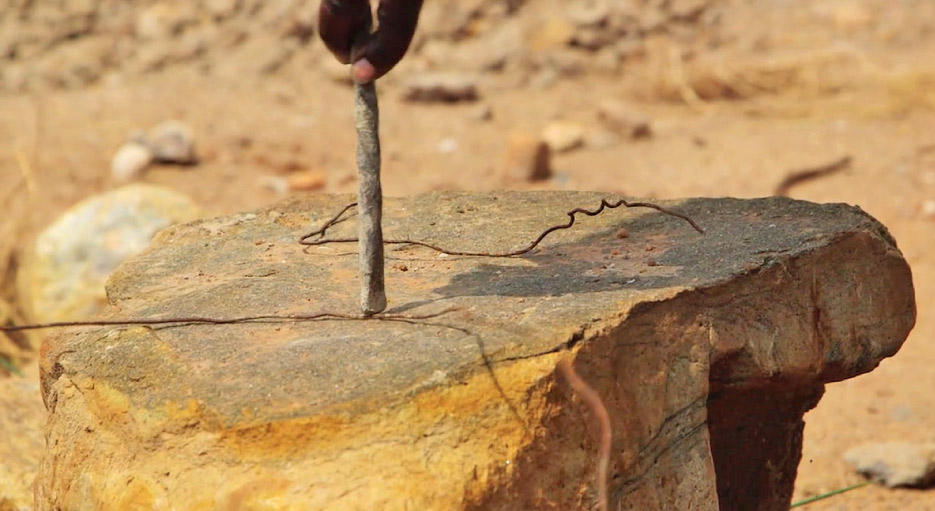 |
|
Above: Masons will form fit a piece of wire, chalk that shape onto a stone, chisel it and refine it into a manageable size. Photo courtesy of MASS Design Group |
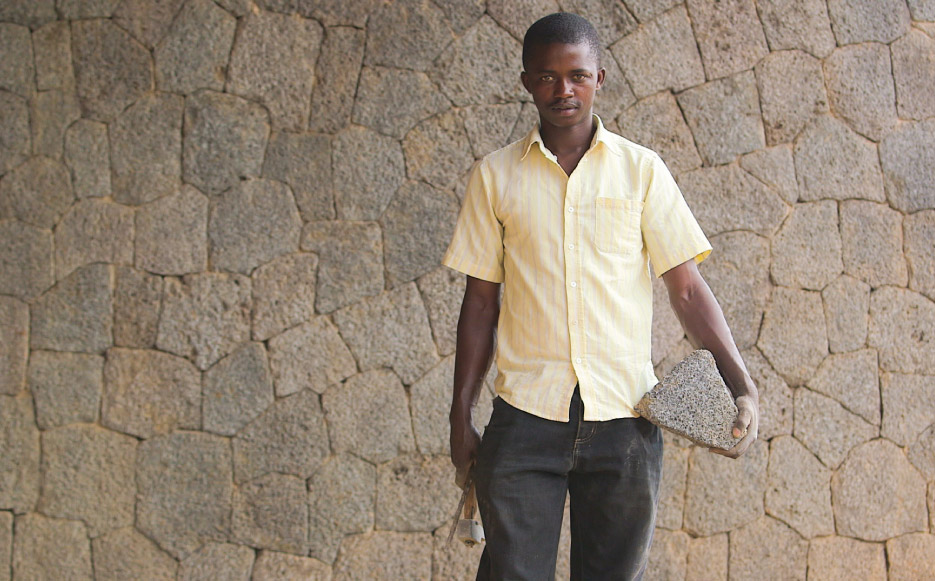 |
|
Above: Master mason Hakizimana Emmanuel describes his experience working with the local stone. “What makes me happy? People in this neighborhood, when we meet, they tell me I have done something beautiful here. I will build my house with this stone.” Photo courtesy of MASS Design Group |
![Above, left: Locals pull pumice stone from the fields which is then collected and used in construction sites. Above, right: “Around the village [Kankwanzi] is changing the life of her colleagues,” says Kayihura Nyundo, engineering consultant to MASS, Rwanda. Above, left: Locals pull pumice stone from the fields which is then collected and used in construction sites. Above, right: “Around the village [Kankwanzi] is changing the life of her colleagues,” says Kayihura Nyundo, engineering consultant to MASS, Rwanda.](/image/07_2022_images/CommonMaterials6-935.jpg) |
|
Above, left: Locals pull pumice stone from the fields which is then collected and used in construction sites.
Photos courtesy of MASS Design Group |
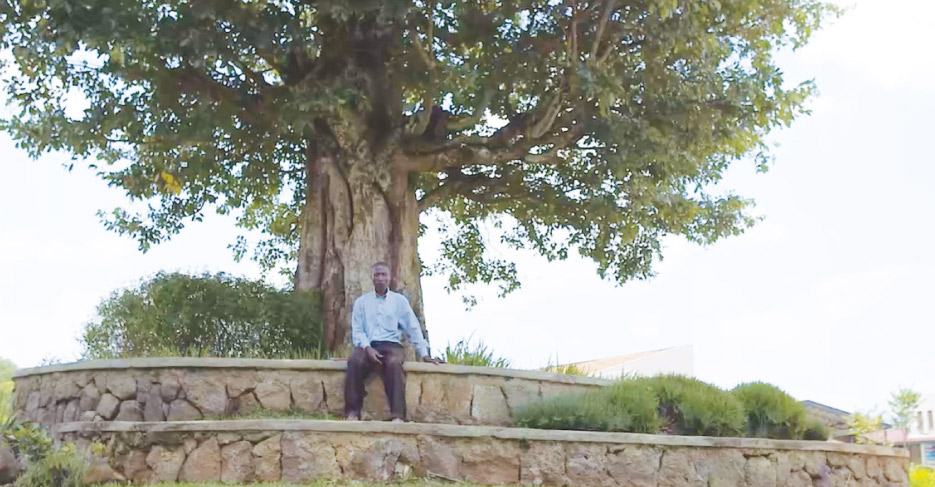 |
|
Above: Landscapes that heal. Master gardener Jean-Baptiste Maniragaba is renown within MASS Design Group for his expression “nziza cyane” which translates as something that makes you happy. He shares a belief that “when the patients are recovering, they look at the gardens and landscape and they feel like everything is going well.” Photo courtesy of MASS Design Group |
 |
|
Anne Marie Nyiranshimiyimana mentored and trained other women in masonry techniques and earned the nickname “Kankwanzi” which is loosely translated as “a rising star that refuses to conform to society’s expectations.” Nyiranshimiyimana said, ‘they told me no woman builds; no woman climbs. They told me women can’t do a lot of things.” She proved the naysayers wrong and rose to the rank of master mason. Photo courtesy of MASS Design Group |
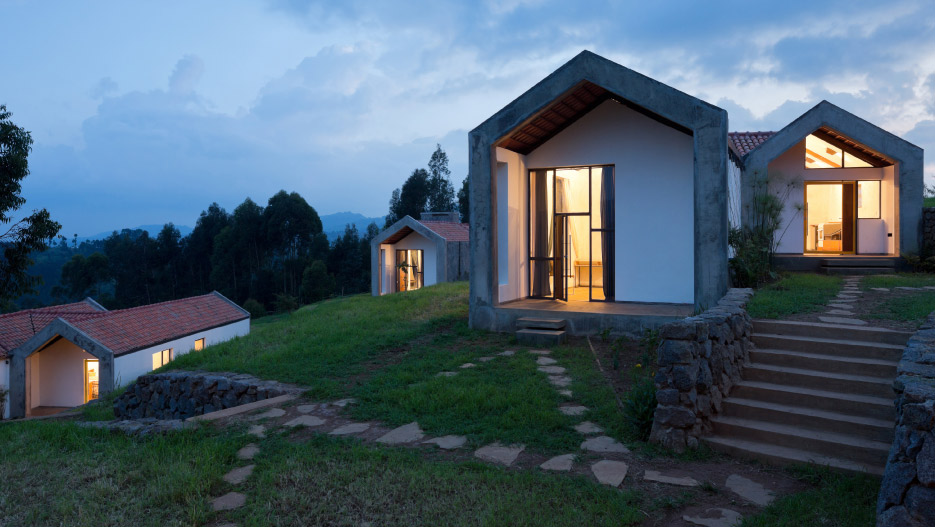 |
|
Butaro Hospital opened in 2011 as part of a 15-year master plan that also includes phase two of doctor housing, a cancer center, and a |
Think Local. Impact Local
Butaro Hospital opened in 2011 as part of a 15-year master plan that also includes phase two of doctor housing, a cancer center, and a university — all featuring local stone.
MASS co-principal Murphy described the effects of these projects to Architect magazine in 2014: “When I first got to Butaro in the beginning of 2008 there was no electricity in the town; there were mostly empty businesses. Not even six years later, there’s a hydroelectric dam in town. In the whole village below the hospital, there’s lots of fresh coats of paint on businesses. A Bank of Kigali has opened up there, not to mention middle-class families are moving to this community because there’s ongoing work at the hospital both in terms of service, nursing, as well as in construction.
“Over the course of these projects, we’ve been able to find really skilled workers. But what’s even more exciting is that we’ve seen these people take those skills and find other jobs because of the recognition they’ve received for the work on these projects. We’ve seen that in different trades such as masonry, welding, weaving, and pottery.”
MASS continues to work on health care projects throughout the developing world in places like Liberia, Burundi, and Haiti. MASS is currently working on a “purpose-built campus” for the Ellen DeGeneres Campus of the Dian Fossey Gorilla Fund, the world’s largest and longest-running organization focused solely on gorilla conservation.
“We’re committed to developing architecture that’s of its place, that looks to the resources of the region. We figure out how we can showcase them and think about social and environmental implications of what we choose to build with,” Ricks says. In the case of Butaro Hospital, “to know [we’ve used] low carbon, climate positive materials that create jobs and are ethically sourced, produced, and installed — that’s what we [in the building industry] should be thinking about. Even when you’re not able to do that all yourself, it’s worth asking the questions, ‘Where do these things come from? Are they ethically harvested, manufactured, and extracted?’ and ‘What is the social and environmental footprint that they have?’”
This article originally appeared in the Fall 2021 issue of Building Stone Magazine. Visit www.buildingstonemagazine.com to read more.